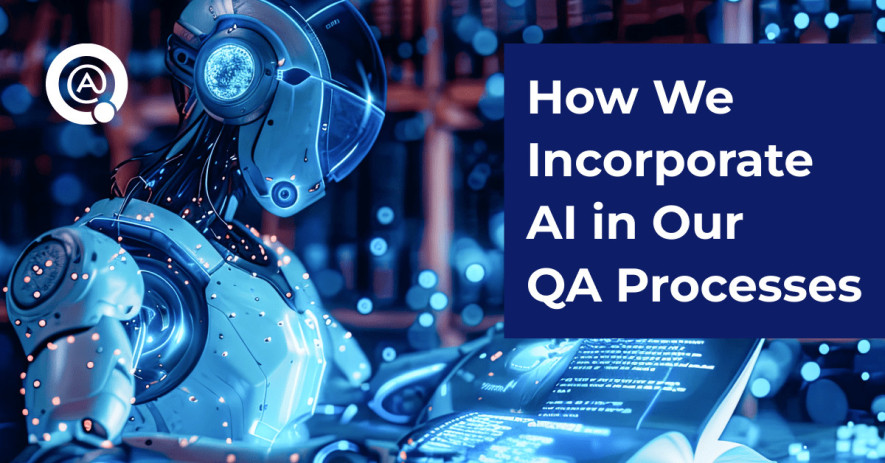- QATestLab Blog >
- QA for Business >
- Industries Insights >
- How We Incorporate AI in Our QA Processes
In today’s rapidly evolving technology landscape, Quality Assurance (QA) processes are crucial to delivering software products that meet customer expectations and maintain high standards of reliability. The integration of Artificial Intelligence (AI) in QA is a game-changer that has significantly transformed the way companies approach software testing. By automating repetitive tasks, analyzing large sets of data, and providing intelligent insights, AI not only optimizes the QA workflow but also ensures higher accuracy and efficiency.
This article delves into the various ways in which AI is being utilized in our QA processes, highlighting the tangible benefits and key areas where it is making a difference. We explore how AI enhances documentation, optimizes test coverage, improves defect detection, and enables smarter decision-making through data analysis.
Automating Documentation and Reporting
Documentation is an essential part of the QA process, covering everything from test plans and cases to bug reports and test execution summaries. Traditionally, creating and maintaining this documentation has been a labor-intensive and error-prone task. However, AI has introduced new levels of efficiency by automating much of this work.
Using Natural Language Processing (NLP) and Machine Learning (ML) algorithms, AI tools can now generate detailed and standardized reports with minimal human intervention. These tools extract relevant data from test execution results and transform them into comprehensive reports that provide a clear picture of the testing progress and any issues encountered. By automating documentation, we not only save time but also ensure consistency and accuracy in reporting, which are crucial for tracking project health and compliance.
Additionally, AI automatically updates documentation in real time as changes are made to the codebase or as new test cases are added. This dynamic approach to documentation management reduces the overhead on QA teams, allowing them to focus on more complex testing tasks rather than administrative work.
Information Gathering and Analysis
Our QA teams often need to stay up-to-date with a myriad of tools, frameworks, and technologies to perform their tasks effectively. Traditionally, gathering information about new tools or understanding the nuances of complex software systems required considerable time and effort. AI has revolutionized this aspect for us by enabling automated research and analysis.
For example, AI-driven tools scan vast amounts of information from technical documents, knowledge bases, and online resources to quickly gather insights about any new tools or updates to existing frameworks. This capability is particularly useful when onboarding new team members or when working on a project that requires knowledge of unfamiliar technologies. The AI system can act as a virtual assistant, providing quick answers to technical questions and suggesting the best practices for using a particular tool or technology.
By leveraging AI for information gathering, our QA teams can reduce the time spent on research and ensure that they are always equipped with the latest knowledge to tackle testing challenges.
Intelligent Test Case Creation and Prioritization
Creating effective test cases is one of the most critical aspects of QA. Test cases must cover all potential scenarios to ensure comprehensive testing, but they must also be optimized to avoid redundant or unnecessary tests. AI helps us address this challenge by automatically generating and prioritizing test cases based on risk analysis, historical data, and application behavior.
AI algorithms analyze past test execution data to identify patterns and suggest test cases that are more likely to find defects. Moreover, by using techniques like model-based testing, AI simulates different user journeys and interactions within the application, ensuring that edge cases and complex scenarios are not overlooked.
Once the test cases are generated, AI prioritize them based on factors such as code complexity, recent changes, and the potential impact of defects. This prioritization helps the QA team focus on the most critical areas first, improving the efficiency and effectiveness of the testing process.
Smart Defect Detection and Resolution
Defect detection is at the heart of QA, and AI has significantly enhanced our ability to identify and resolve issues early in the development cycle. Traditional testing approaches rely heavily on predefined test cases and human observation to catch defects, but AI brings a more proactive approach to defect detection.
Using techniques such as anomaly detection, AI analyzes code behavior and execution patterns to detect deviations from the expected performance. These anomalies often indicate the presence of bugs or potential points of failure that might not be immediately visible through standard testing. Additionally, AI’s ability to learn from past data allows it to predict defect-prone areas in the code, enabling teams to focus their testing efforts where they are needed most.
AI can also suggest potential fixes for identified issues by analyzing similar defects in the past and recommending solutions based on historical data. This accelerates the debugging process and reduces the overall time to resolution, helping teams deliver high-quality software faster.
Advanced Data Analysis and Insights
Data is a valuable asset in QA, providing insights into testing performance, code quality, and project health. However, manually analyzing large sets of test data can be overwhelming and prone to human error. We address this challenge with AI by automating data analysis and offering actionable insights that can guide decision-making.
AI-powered analytics tools process vast amounts of test data to identify trends, anomalies, and correlations that might not be apparent through manual analysis. For example, with AI we track test execution times, failure rates, and defect densities to pinpoint areas where testing efficiency can be improved. These insights help our QA managers allocate resources more effectively and prioritize testing activities based on data-driven criteria.
Conclusion
The incorporation of AI into our QA processes has revolutionized the way we approach software testing. By automating repetitive tasks, enhancing defect detection, and providing intelligent insights, AI empowers us to deliver higher-quality software in less time. As AI technology continues to evolve, we are committed to exploring new ways to leverage its potential, ensuring that our QA strategies remain at the forefront of innovation.
By embracing AI, we are not only improving our own processes but also delivering greater value to our clients through faster releases, more reliable products, and a commitment to excellence. The future of QA lies in the seamless integration of AI and human expertise, and we are excited to be a part of this transformative journey.
Learn more from QATestLab
Related Posts:
- Warning Signs: How to Identify Inefficient Test Automation in Your Project
- TOP 10 Artificial Intelligence (AI) Startups You should Know
- Artificial Intelligence: adoption and obstacles
About Article Author
view more articles







